Exploring Leadership Theories and Management Approaches Report
VerifiedAdded on 2024/06/07
|18
|4278
|71
Report
AI Summary
This report provides a comprehensive analysis of leadership and management, emphasizing their interconnectedness in achieving organizational goals. It explores various leadership theories and approaches, including trait approaches, functional approaches, and behavioral styles. The report delves into the qualities and skills necessary for successful leadership, such as critical thinking, initiative, and effective communication. It also distinguishes between leadership and management, highlighting the importance of adapting leadership styles to different situations and fostering positive relationships within the organization. The analysis includes a reflection on personal leadership experiences, concluding with the vital role of leadership skills in career development and organizational success.

BUSINESS LEADERSHIP AND MANAGEMENT
1
1
Paraphrase This Document
Need a fresh take? Get an instant paraphrase of this document with our AI Paraphraser
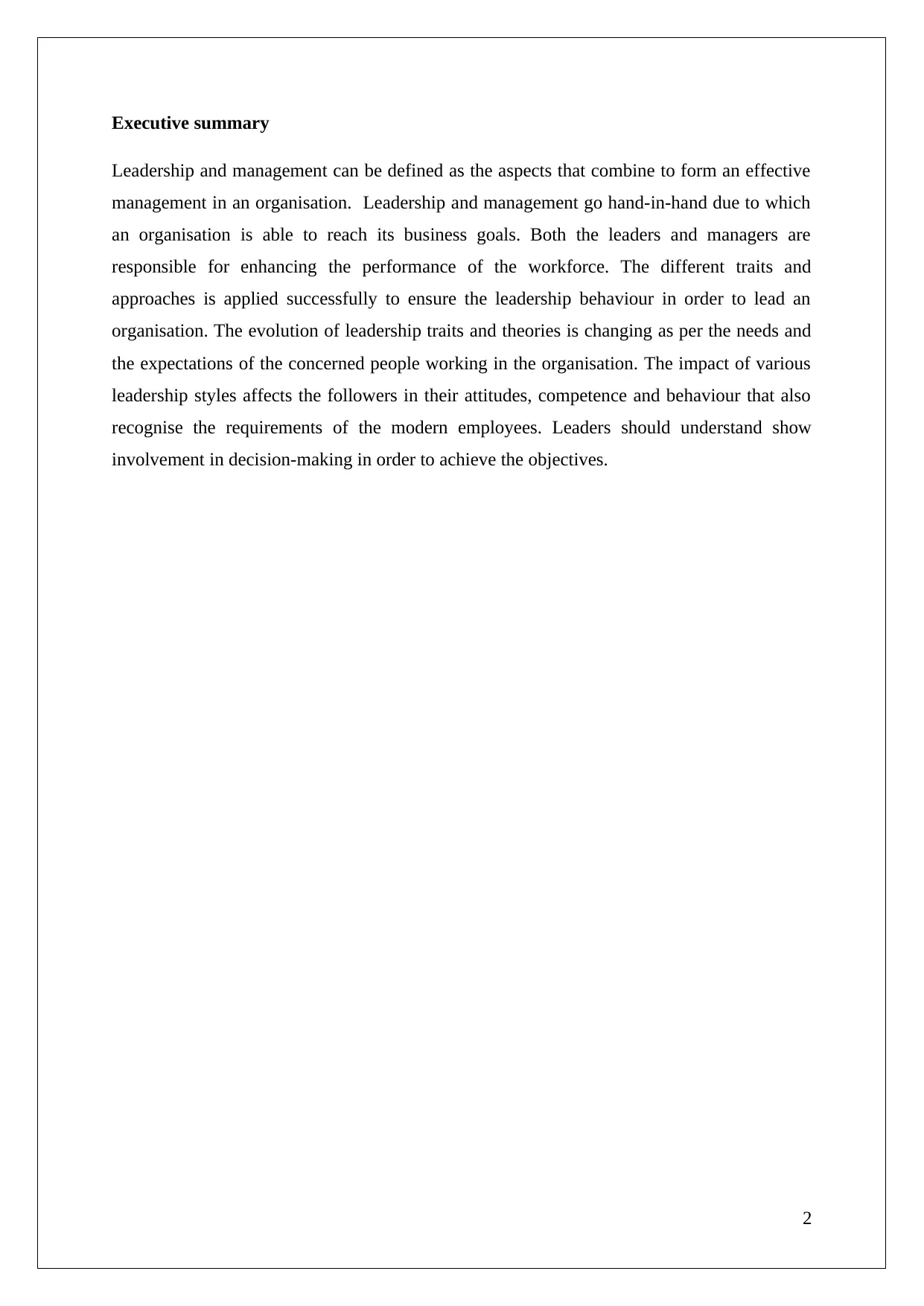
Executive summary
Leadership and management can be defined as the aspects that combine to form an effective
management in an organisation. Leadership and management go hand-in-hand due to which
an organisation is able to reach its business goals. Both the leaders and managers are
responsible for enhancing the performance of the workforce. The different traits and
approaches is applied successfully to ensure the leadership behaviour in order to lead an
organisation. The evolution of leadership traits and theories is changing as per the needs and
the expectations of the concerned people working in the organisation. The impact of various
leadership styles affects the followers in their attitudes, competence and behaviour that also
recognise the requirements of the modern employees. Leaders should understand show
involvement in decision-making in order to achieve the objectives.
2
Leadership and management can be defined as the aspects that combine to form an effective
management in an organisation. Leadership and management go hand-in-hand due to which
an organisation is able to reach its business goals. Both the leaders and managers are
responsible for enhancing the performance of the workforce. The different traits and
approaches is applied successfully to ensure the leadership behaviour in order to lead an
organisation. The evolution of leadership traits and theories is changing as per the needs and
the expectations of the concerned people working in the organisation. The impact of various
leadership styles affects the followers in their attitudes, competence and behaviour that also
recognise the requirements of the modern employees. Leaders should understand show
involvement in decision-making in order to achieve the objectives.
2

Table of Contents
Introduction................................................................................................................................4
Main Analysis............................................................................................................................5
Approaches and Theories to be applied for being a Successful Leader.....................................5
Developing Good Leadership..................................................................................................11
Leadership and management....................................................................................................12
Reflection on own leadership experience................................................................................14
Conclusion................................................................................................................................16
Reference List..........................................................................................................................17
3
Introduction................................................................................................................................4
Main Analysis............................................................................................................................5
Approaches and Theories to be applied for being a Successful Leader.....................................5
Developing Good Leadership..................................................................................................11
Leadership and management....................................................................................................12
Reflection on own leadership experience................................................................................14
Conclusion................................................................................................................................16
Reference List..........................................................................................................................17
3
⊘ This is a preview!⊘
Do you want full access?
Subscribe today to unlock all pages.

Trusted by 1+ million students worldwide

Introduction
Leadership refers to the activities that a leader adopts in an organisation to lead the
employees or the group in order to meet the business objectives.. Leadership skills reflect the
ability to direct, control, and guide a particular group for a given task and achieve the targets..
Management skills refer to the activities in controlling the specified operations successfully
in the place. It interlocks the functions to create corporate policies while planning, controlling
and organising the business objectives effectively managing the different areas. The report
will define the different approaches and theories stating the application of leadership skills to
be adopted by a leader. The report will also distinguish between leadership and management
in order to understand the different approaches reflecting the two critical components in the
business organisation.
4
Leadership refers to the activities that a leader adopts in an organisation to lead the
employees or the group in order to meet the business objectives.. Leadership skills reflect the
ability to direct, control, and guide a particular group for a given task and achieve the targets..
Management skills refer to the activities in controlling the specified operations successfully
in the place. It interlocks the functions to create corporate policies while planning, controlling
and organising the business objectives effectively managing the different areas. The report
will define the different approaches and theories stating the application of leadership skills to
be adopted by a leader. The report will also distinguish between leadership and management
in order to understand the different approaches reflecting the two critical components in the
business organisation.
4
Paraphrase This Document
Need a fresh take? Get an instant paraphrase of this document with our AI Paraphraser

Main Analysis
Approaches and Theories to be applied for being a Successful Leader
Theories and approaches
The theories include the wide varieties of leadership skills and approaches that explain the
practices and concept of the leadership skills that is to be adopted by a leader. Leadership
involves influencing the people in understanding about the business goals. The approaches to
leadership reflect the empowerment and working in the different levels of leadership skill to
ensure the growth of a leader in all aspects (Dinh et al., 2014).
Traits approaches: The approaches in leadership theory are different qualities or traits that a
leader should have to lead people. As per this theory, certain personality traits tend to set a
leader apart from others (Daft, 2014).
Functional approaches: It states that the leadership can be developed and can be learned.
The approach focuses on the different responsibilities, functions and accountabilities of a
leader while understanding the nature of the group. The approach refers to the leadership
theories that reflects the behavioural effects the followers, the main key theory reflects the
Adair’s Action Centred Leadership theory that focuses on the leader approaches to balance
the requirements of an individual, team and the business objectives (Santos et al., 2015).
Behavioural style of approach: The style focuses on the individual behaviour in terms of
leadership positions that highly influence the group performances in understanding the right
leadership style in the workplace (Williams, 2017). The following aspects involve the
successful leader that is based upon the three main leadership styles with the people:
5
Approaches and Theories to be applied for being a Successful Leader
Theories and approaches
The theories include the wide varieties of leadership skills and approaches that explain the
practices and concept of the leadership skills that is to be adopted by a leader. Leadership
involves influencing the people in understanding about the business goals. The approaches to
leadership reflect the empowerment and working in the different levels of leadership skill to
ensure the growth of a leader in all aspects (Dinh et al., 2014).
Traits approaches: The approaches in leadership theory are different qualities or traits that a
leader should have to lead people. As per this theory, certain personality traits tend to set a
leader apart from others (Daft, 2014).
Functional approaches: It states that the leadership can be developed and can be learned.
The approach focuses on the different responsibilities, functions and accountabilities of a
leader while understanding the nature of the group. The approach refers to the leadership
theories that reflects the behavioural effects the followers, the main key theory reflects the
Adair’s Action Centred Leadership theory that focuses on the leader approaches to balance
the requirements of an individual, team and the business objectives (Santos et al., 2015).
Behavioural style of approach: The style focuses on the individual behaviour in terms of
leadership positions that highly influence the group performances in understanding the right
leadership style in the workplace (Williams, 2017). The following aspects involve the
successful leader that is based upon the three main leadership styles with the people:
5
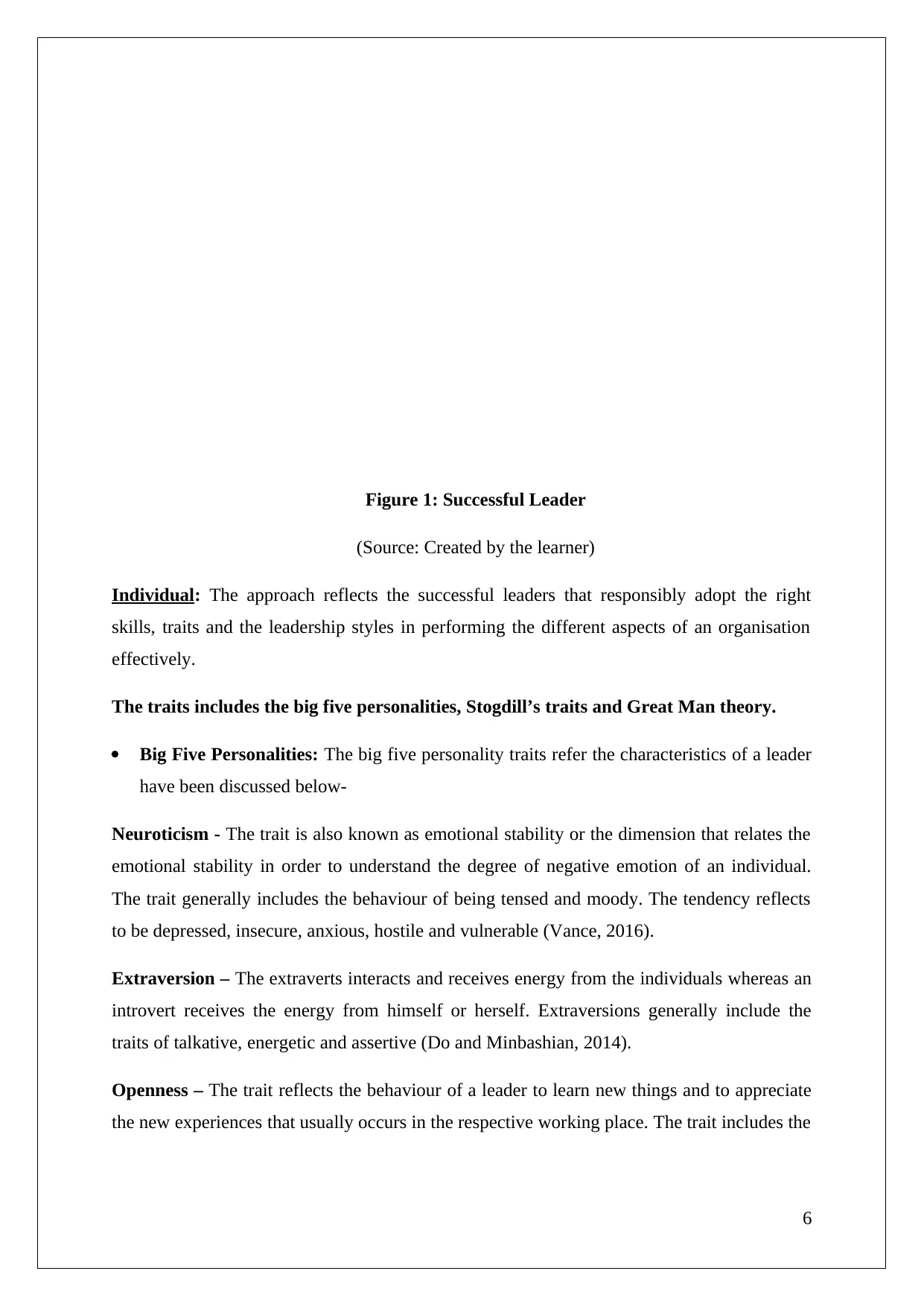
Figure 1: Successful Leader
(Source: Created by the learner)
Individual: The approach reflects the successful leaders that responsibly adopt the right
skills, traits and the leadership styles in performing the different aspects of an organisation
effectively.
The traits includes the big five personalities, Stogdill’s traits and Great Man theory.
Big Five Personalities: The big five personality traits refer the characteristics of a leader
have been discussed below-
Neuroticism - The trait is also known as emotional stability or the dimension that relates the
emotional stability in order to understand the degree of negative emotion of an individual.
The trait generally includes the behaviour of being tensed and moody. The tendency reflects
to be depressed, insecure, anxious, hostile and vulnerable (Vance, 2016).
Extraversion – The extraverts interacts and receives energy from the individuals whereas an
introvert receives the energy from himself or herself. Extraversions generally include the
traits of talkative, energetic and assertive (Do and Minbashian, 2014).
Openness – The trait reflects the behaviour of a leader to learn new things and to appreciate
the new experiences that usually occurs in the respective working place. The trait includes the
6
(Source: Created by the learner)
Individual: The approach reflects the successful leaders that responsibly adopt the right
skills, traits and the leadership styles in performing the different aspects of an organisation
effectively.
The traits includes the big five personalities, Stogdill’s traits and Great Man theory.
Big Five Personalities: The big five personality traits refer the characteristics of a leader
have been discussed below-
Neuroticism - The trait is also known as emotional stability or the dimension that relates the
emotional stability in order to understand the degree of negative emotion of an individual.
The trait generally includes the behaviour of being tensed and moody. The tendency reflects
to be depressed, insecure, anxious, hostile and vulnerable (Vance, 2016).
Extraversion – The extraverts interacts and receives energy from the individuals whereas an
introvert receives the energy from himself or herself. Extraversions generally include the
traits of talkative, energetic and assertive (Do and Minbashian, 2014).
Openness – The trait reflects the behaviour of a leader to learn new things and to appreciate
the new experiences that usually occurs in the respective working place. The trait includes the
6
⊘ This is a preview!⊘
Do you want full access?
Subscribe today to unlock all pages.

Trusted by 1+ million students worldwide

ability to be imaginative and insightful in nature while having a wide variety of interests. The
tendency to this trait states to be informative, curious and creative in the workplace.
Agreeableness – The trait refers to the individuals those are more friendly, compassionate
and cooperative in nature. The person with these qualities reflects to be more kind,
sympathetic and affectionate in the working field. The tendency of the person adopting the
trait show more organised, decisive and controlled towards his or her working nature.
Conscientiousness - The trait reflects the individual with high reliability and promptness that
also includes being methodical, thorough and organised in nature.
Stodgill’s Traits: The trait has been conducted in 1974 by Stodgill in finding both the
leadership traits and variables that contributes to develop a better leadership quality in the
working environment. The trait are the different characteristics that includes intelligence,
self-confidence, knowledge, responsibility, cooperativeness, tolerance, sociability
imitativeness and persistence (Owens, 2014).
Great Man Theory: The theories refers to the determined leadership skills and traits that
has been studied in early 20th century to create great leaders in different working places.
The theories have been developed effectively to focus on the initiated qualities of a leader
that possess great political, military and social leaders. The development of such theories
is termed be the Great Man theories (Chand, 2015).
The skills include Katz’s Three Skill Model and Skills-Based Model:
Katz’s Three Skills Model: Robert Katz has argued that the three effective leadership
skills are required to complete the traits are technical skills, human skills and conceptual
skills. The technical skill is about having complete knowledge about the work or the
activity that a leader is concerned about. Human skill refers to the self-awareness about
both self and other perspectives in a same time. Moreover, it is to motivate and be
sensitive towards others working in the same environment. Conceptual skills refer to an
individual ability to act with logical concepts and ideas while conceptualising the vision
and plan for the organisation (Katz, 2015).
7
tendency to this trait states to be informative, curious and creative in the workplace.
Agreeableness – The trait refers to the individuals those are more friendly, compassionate
and cooperative in nature. The person with these qualities reflects to be more kind,
sympathetic and affectionate in the working field. The tendency of the person adopting the
trait show more organised, decisive and controlled towards his or her working nature.
Conscientiousness - The trait reflects the individual with high reliability and promptness that
also includes being methodical, thorough and organised in nature.
Stodgill’s Traits: The trait has been conducted in 1974 by Stodgill in finding both the
leadership traits and variables that contributes to develop a better leadership quality in the
working environment. The trait are the different characteristics that includes intelligence,
self-confidence, knowledge, responsibility, cooperativeness, tolerance, sociability
imitativeness and persistence (Owens, 2014).
Great Man Theory: The theories refers to the determined leadership skills and traits that
has been studied in early 20th century to create great leaders in different working places.
The theories have been developed effectively to focus on the initiated qualities of a leader
that possess great political, military and social leaders. The development of such theories
is termed be the Great Man theories (Chand, 2015).
The skills include Katz’s Three Skill Model and Skills-Based Model:
Katz’s Three Skills Model: Robert Katz has argued that the three effective leadership
skills are required to complete the traits are technical skills, human skills and conceptual
skills. The technical skill is about having complete knowledge about the work or the
activity that a leader is concerned about. Human skill refers to the self-awareness about
both self and other perspectives in a same time. Moreover, it is to motivate and be
sensitive towards others working in the same environment. Conceptual skills refer to an
individual ability to act with logical concepts and ideas while conceptualising the vision
and plan for the organisation (Katz, 2015).
7
Paraphrase This Document
Need a fresh take? Get an instant paraphrase of this document with our AI Paraphraser
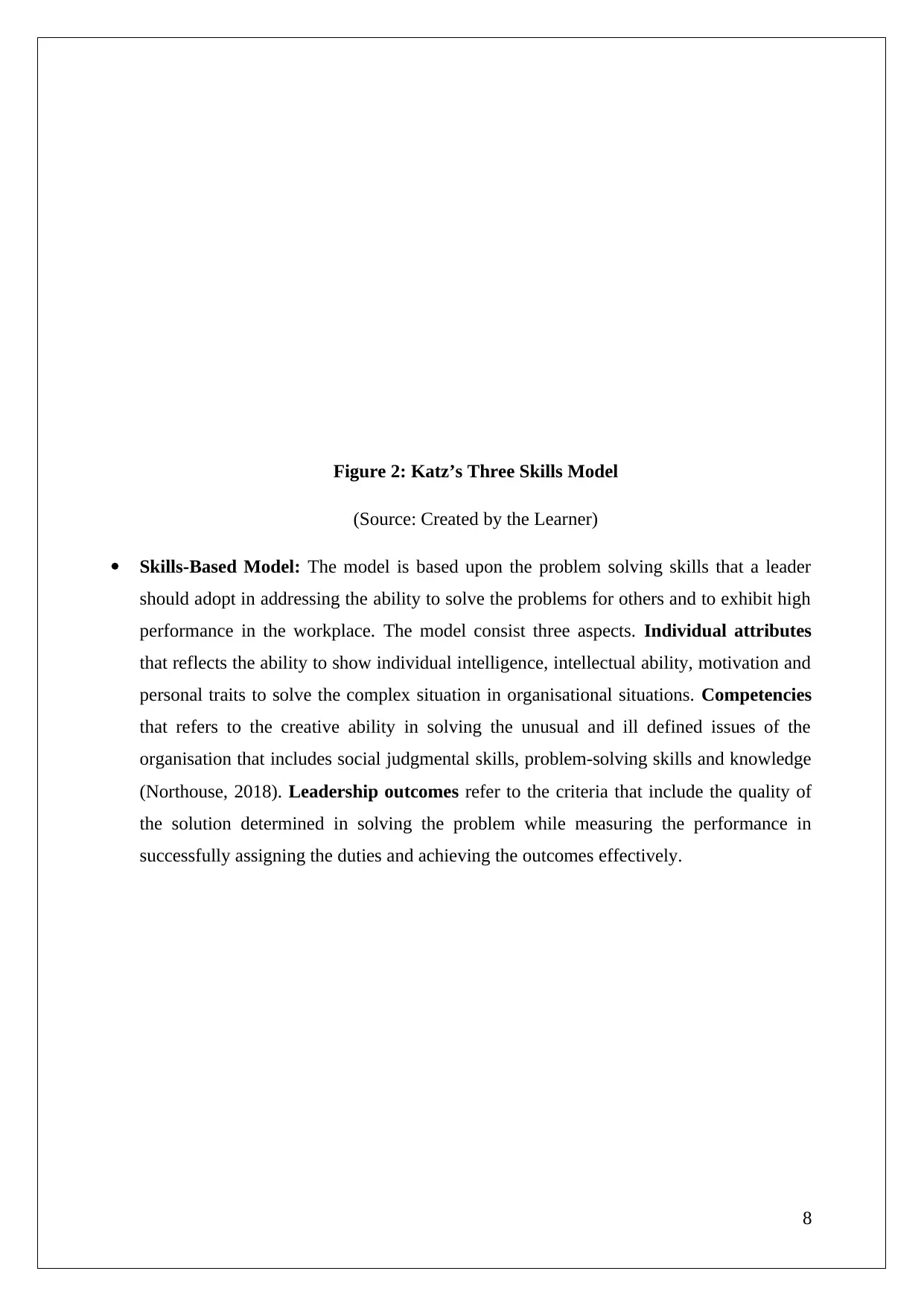
Figure 2: Katz’s Three Skills Model
(Source: Created by the Learner)
Skills-Based Model: The model is based upon the problem solving skills that a leader
should adopt in addressing the ability to solve the problems for others and to exhibit high
performance in the workplace. The model consist three aspects. Individual attributes
that reflects the ability to show individual intelligence, intellectual ability, motivation and
personal traits to solve the complex situation in organisational situations. Competencies
that refers to the creative ability in solving the unusual and ill defined issues of the
organisation that includes social judgmental skills, problem-solving skills and knowledge
(Northouse, 2018). Leadership outcomes refer to the criteria that include the quality of
the solution determined in solving the problem while measuring the performance in
successfully assigning the duties and achieving the outcomes effectively.
8
Katz'sThreeSkillApproachTechnicalSkillsHumanSkillsConceptualSkills
(Source: Created by the Learner)
Skills-Based Model: The model is based upon the problem solving skills that a leader
should adopt in addressing the ability to solve the problems for others and to exhibit high
performance in the workplace. The model consist three aspects. Individual attributes
that reflects the ability to show individual intelligence, intellectual ability, motivation and
personal traits to solve the complex situation in organisational situations. Competencies
that refers to the creative ability in solving the unusual and ill defined issues of the
organisation that includes social judgmental skills, problem-solving skills and knowledge
(Northouse, 2018). Leadership outcomes refer to the criteria that include the quality of
the solution determined in solving the problem while measuring the performance in
successfully assigning the duties and achieving the outcomes effectively.
8
Katz'sThreeSkillApproachTechnicalSkillsHumanSkillsConceptualSkills
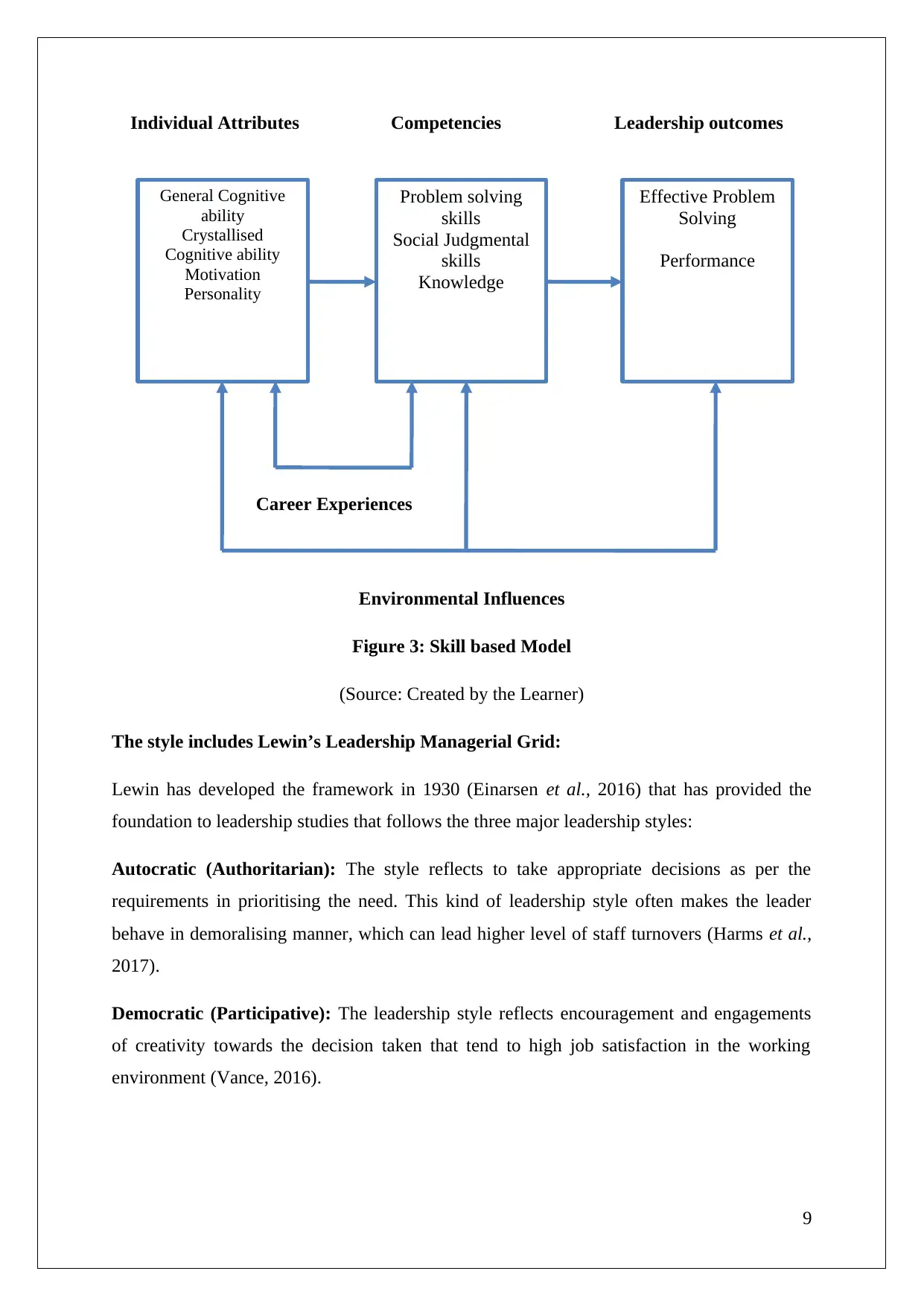
General Cognitive
ability
Crystallised
Cognitive ability
Motivation
Personality
Problem solving
skills
Social Judgmental
skills
Knowledge
Effective Problem
Solving
Performance
Individual Attributes Competencies Leadership outcomes
Career Experiences
Environmental Influences
Figure 3: Skill based Model
(Source: Created by the Learner)
The style includes Lewin’s Leadership Managerial Grid:
Lewin has developed the framework in 1930 (Einarsen et al., 2016) that has provided the
foundation to leadership studies that follows the three major leadership styles:
Autocratic (Authoritarian): The style reflects to take appropriate decisions as per the
requirements in prioritising the need. This kind of leadership style often makes the leader
behave in demoralising manner, which can lead higher level of staff turnovers (Harms et al.,
2017).
Democratic (Participative): The leadership style reflects encouragement and engagements
of creativity towards the decision taken that tend to high job satisfaction in the working
environment (Vance, 2016).
9
ability
Crystallised
Cognitive ability
Motivation
Personality
Problem solving
skills
Social Judgmental
skills
Knowledge
Effective Problem
Solving
Performance
Individual Attributes Competencies Leadership outcomes
Career Experiences
Environmental Influences
Figure 3: Skill based Model
(Source: Created by the Learner)
The style includes Lewin’s Leadership Managerial Grid:
Lewin has developed the framework in 1930 (Einarsen et al., 2016) that has provided the
foundation to leadership studies that follows the three major leadership styles:
Autocratic (Authoritarian): The style reflects to take appropriate decisions as per the
requirements in prioritising the need. This kind of leadership style often makes the leader
behave in demoralising manner, which can lead higher level of staff turnovers (Harms et al.,
2017).
Democratic (Participative): The leadership style reflects encouragement and engagements
of creativity towards the decision taken that tend to high job satisfaction in the working
environment (Vance, 2016).
9
⊘ This is a preview!⊘
Do you want full access?
Subscribe today to unlock all pages.

Trusted by 1+ million students worldwide

Laissez faire (Delegative): The style requires the leader to support the staffs and employees
with right resources and advices that enhance the knowledge and skills of the employees
working in the organisation (Cherry, 2016).
Contextual: The trait defines the approaches that combine successful leaders that show the
ability to adapt the leadership approaches in order to meet the different needs and
requirements of the different situations and the people present in the organisation. It includes
the following approaches, theory and model to recognise the leadership trait:
Situational Approach and Contingency Model: The approach refers to the
organisational situations that determine the effective leadership style in identifying the
most efficient leadership style appropriate to the changing situations (McCleskey,
2014).
Path Goal Theory: The theory specifies the leadership style or behaviour in
achieving the organisational objectives or goals. The goals mainly include the
assurance to employee motivation, satisfaction and empowerments to achieve
productive participation in the organisation (Ma and Tsui, 2015).
Rational: The leadership approach defines the successful leaders that develop valuable and
positive relationship with the individuals and the various departments present in the
organisation. The relationship is an important aspect that helps a leader to acknowledge and
understand the requirements of the organisational departments (Northouse, 2018).
Servant Leadership: The style refers to the philosophy to set the leadership practices
that reflects to enrich the individual lives and to build an efficient organisation while
creating a better environment (Liden et al., 2014).
Transformational Leadership: The leadership skill ensures to create a clear vision
in transforming the organisational performances that appeals better ideas and values
in the organisation. The employees or staffs get motivated from the environment
rather than by acknowledging his or her self interests and provide more efforts in the
workplace (Banks et al., 2016).
Leader Member Exchange Theory: The theory refers to a relationship based
approaches that focus on dyadic relationship within a leader and the followers. The
theory suggests the leader to choose best offers for the employees and the members of
the respective team (Jian, 2016).
10
with right resources and advices that enhance the knowledge and skills of the employees
working in the organisation (Cherry, 2016).
Contextual: The trait defines the approaches that combine successful leaders that show the
ability to adapt the leadership approaches in order to meet the different needs and
requirements of the different situations and the people present in the organisation. It includes
the following approaches, theory and model to recognise the leadership trait:
Situational Approach and Contingency Model: The approach refers to the
organisational situations that determine the effective leadership style in identifying the
most efficient leadership style appropriate to the changing situations (McCleskey,
2014).
Path Goal Theory: The theory specifies the leadership style or behaviour in
achieving the organisational objectives or goals. The goals mainly include the
assurance to employee motivation, satisfaction and empowerments to achieve
productive participation in the organisation (Ma and Tsui, 2015).
Rational: The leadership approach defines the successful leaders that develop valuable and
positive relationship with the individuals and the various departments present in the
organisation. The relationship is an important aspect that helps a leader to acknowledge and
understand the requirements of the organisational departments (Northouse, 2018).
Servant Leadership: The style refers to the philosophy to set the leadership practices
that reflects to enrich the individual lives and to build an efficient organisation while
creating a better environment (Liden et al., 2014).
Transformational Leadership: The leadership skill ensures to create a clear vision
in transforming the organisational performances that appeals better ideas and values
in the organisation. The employees or staffs get motivated from the environment
rather than by acknowledging his or her self interests and provide more efforts in the
workplace (Banks et al., 2016).
Leader Member Exchange Theory: The theory refers to a relationship based
approaches that focus on dyadic relationship within a leader and the followers. The
theory suggests the leader to choose best offers for the employees and the members of
the respective team (Jian, 2016).
10
Paraphrase This Document
Need a fresh take? Get an instant paraphrase of this document with our AI Paraphraser
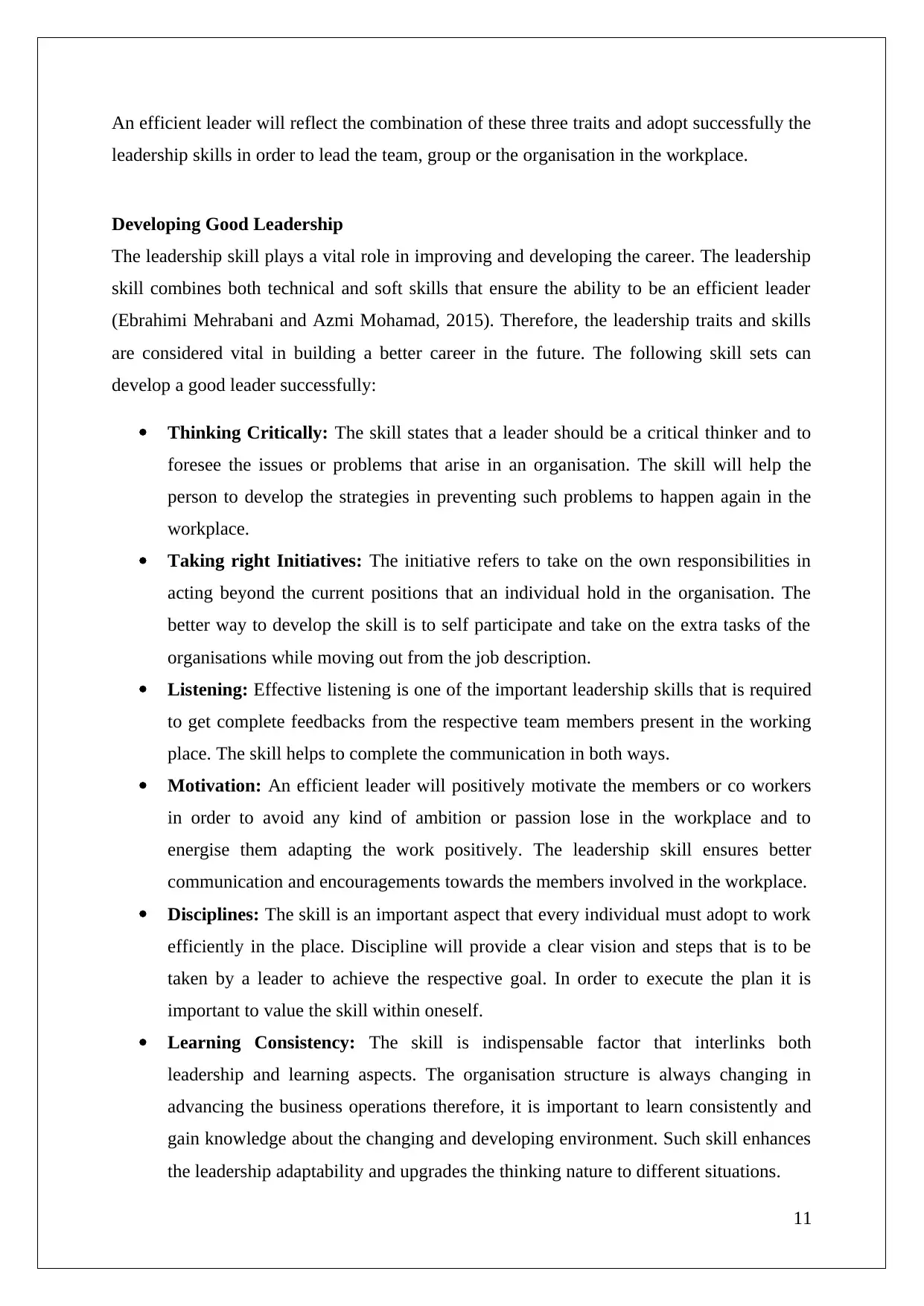
An efficient leader will reflect the combination of these three traits and adopt successfully the
leadership skills in order to lead the team, group or the organisation in the workplace.
Developing Good Leadership
The leadership skill plays a vital role in improving and developing the career. The leadership
skill combines both technical and soft skills that ensure the ability to be an efficient leader
(Ebrahimi Mehrabani and Azmi Mohamad, 2015). Therefore, the leadership traits and skills
are considered vital in building a better career in the future. The following skill sets can
develop a good leader successfully:
Thinking Critically: The skill states that a leader should be a critical thinker and to
foresee the issues or problems that arise in an organisation. The skill will help the
person to develop the strategies in preventing such problems to happen again in the
workplace.
Taking right Initiatives: The initiative refers to take on the own responsibilities in
acting beyond the current positions that an individual hold in the organisation. The
better way to develop the skill is to self participate and take on the extra tasks of the
organisations while moving out from the job description.
Listening: Effective listening is one of the important leadership skills that is required
to get complete feedbacks from the respective team members present in the working
place. The skill helps to complete the communication in both ways.
Motivation: An efficient leader will positively motivate the members or co workers
in order to avoid any kind of ambition or passion lose in the workplace and to
energise them adapting the work positively. The leadership skill ensures better
communication and encouragements towards the members involved in the workplace.
Disciplines: The skill is an important aspect that every individual must adopt to work
efficiently in the place. Discipline will provide a clear vision and steps that is to be
taken by a leader to achieve the respective goal. In order to execute the plan it is
important to value the skill within oneself.
Learning Consistency: The skill is indispensable factor that interlinks both
leadership and learning aspects. The organisation structure is always changing in
advancing the business operations therefore, it is important to learn consistently and
gain knowledge about the changing and developing environment. Such skill enhances
the leadership adaptability and upgrades the thinking nature to different situations.
11
leadership skills in order to lead the team, group or the organisation in the workplace.
Developing Good Leadership
The leadership skill plays a vital role in improving and developing the career. The leadership
skill combines both technical and soft skills that ensure the ability to be an efficient leader
(Ebrahimi Mehrabani and Azmi Mohamad, 2015). Therefore, the leadership traits and skills
are considered vital in building a better career in the future. The following skill sets can
develop a good leader successfully:
Thinking Critically: The skill states that a leader should be a critical thinker and to
foresee the issues or problems that arise in an organisation. The skill will help the
person to develop the strategies in preventing such problems to happen again in the
workplace.
Taking right Initiatives: The initiative refers to take on the own responsibilities in
acting beyond the current positions that an individual hold in the organisation. The
better way to develop the skill is to self participate and take on the extra tasks of the
organisations while moving out from the job description.
Listening: Effective listening is one of the important leadership skills that is required
to get complete feedbacks from the respective team members present in the working
place. The skill helps to complete the communication in both ways.
Motivation: An efficient leader will positively motivate the members or co workers
in order to avoid any kind of ambition or passion lose in the workplace and to
energise them adapting the work positively. The leadership skill ensures better
communication and encouragements towards the members involved in the workplace.
Disciplines: The skill is an important aspect that every individual must adopt to work
efficiently in the place. Discipline will provide a clear vision and steps that is to be
taken by a leader to achieve the respective goal. In order to execute the plan it is
important to value the skill within oneself.
Learning Consistency: The skill is indispensable factor that interlinks both
leadership and learning aspects. The organisation structure is always changing in
advancing the business operations therefore, it is important to learn consistently and
gain knowledge about the changing and developing environment. Such skill enhances
the leadership adaptability and upgrades the thinking nature to different situations.
11
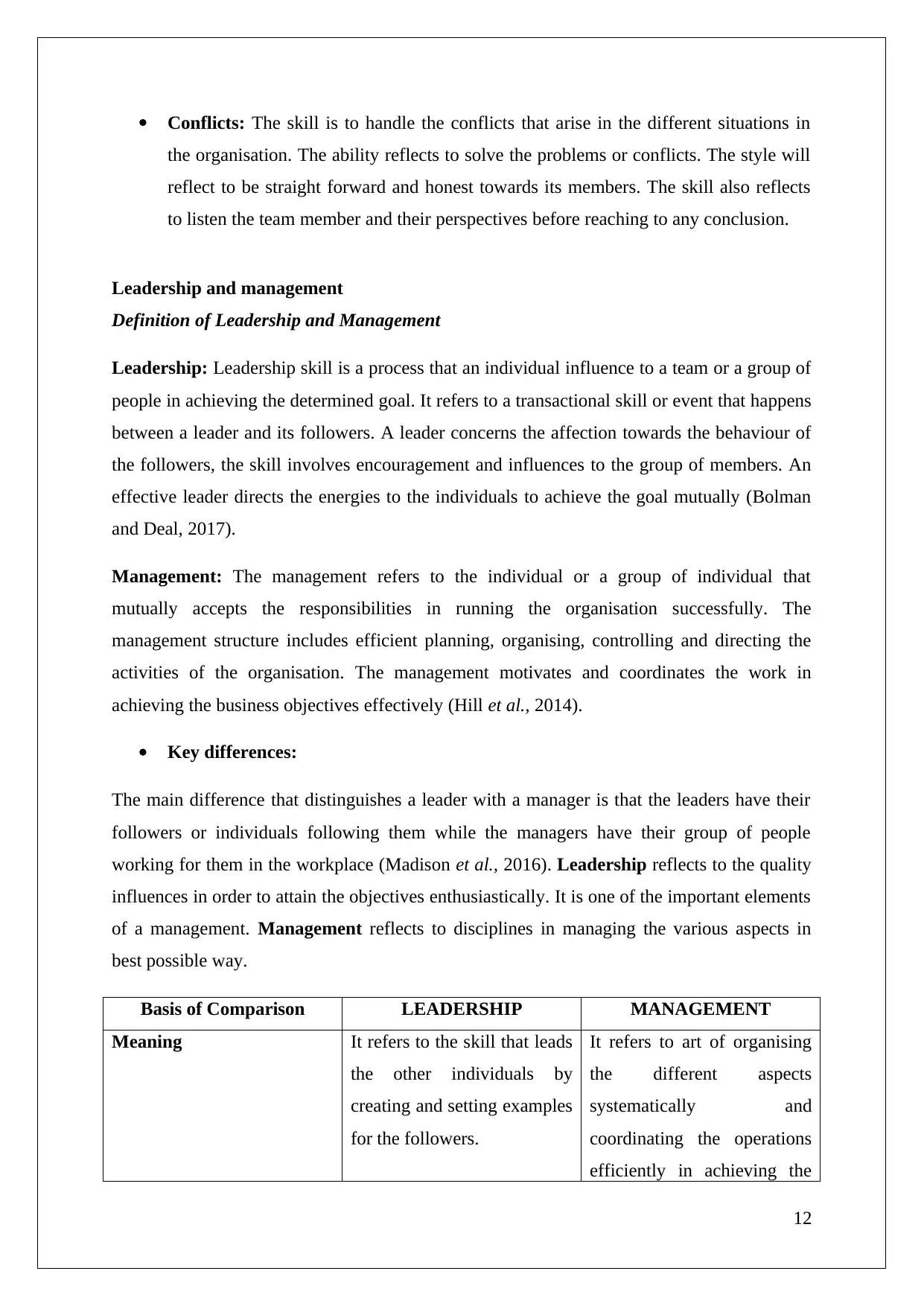
Conflicts: The skill is to handle the conflicts that arise in the different situations in
the organisation. The ability reflects to solve the problems or conflicts. The style will
reflect to be straight forward and honest towards its members. The skill also reflects
to listen the team member and their perspectives before reaching to any conclusion.
Leadership and management
Definition of Leadership and Management
Leadership: Leadership skill is a process that an individual influence to a team or a group of
people in achieving the determined goal. It refers to a transactional skill or event that happens
between a leader and its followers. A leader concerns the affection towards the behaviour of
the followers, the skill involves encouragement and influences to the group of members. An
effective leader directs the energies to the individuals to achieve the goal mutually (Bolman
and Deal, 2017).
Management: The management refers to the individual or a group of individual that
mutually accepts the responsibilities in running the organisation successfully. The
management structure includes efficient planning, organising, controlling and directing the
activities of the organisation. The management motivates and coordinates the work in
achieving the business objectives effectively (Hill et al., 2014).
Key differences:
The main difference that distinguishes a leader with a manager is that the leaders have their
followers or individuals following them while the managers have their group of people
working for them in the workplace (Madison et al., 2016). Leadership reflects to the quality
influences in order to attain the objectives enthusiastically. It is one of the important elements
of a management. Management reflects to disciplines in managing the various aspects in
best possible way.
Basis of Comparison LEADERSHIP MANAGEMENT
Meaning It refers to the skill that leads
the other individuals by
creating and setting examples
for the followers.
It refers to art of organising
the different aspects
systematically and
coordinating the operations
efficiently in achieving the
12
the organisation. The ability reflects to solve the problems or conflicts. The style will
reflect to be straight forward and honest towards its members. The skill also reflects
to listen the team member and their perspectives before reaching to any conclusion.
Leadership and management
Definition of Leadership and Management
Leadership: Leadership skill is a process that an individual influence to a team or a group of
people in achieving the determined goal. It refers to a transactional skill or event that happens
between a leader and its followers. A leader concerns the affection towards the behaviour of
the followers, the skill involves encouragement and influences to the group of members. An
effective leader directs the energies to the individuals to achieve the goal mutually (Bolman
and Deal, 2017).
Management: The management refers to the individual or a group of individual that
mutually accepts the responsibilities in running the organisation successfully. The
management structure includes efficient planning, organising, controlling and directing the
activities of the organisation. The management motivates and coordinates the work in
achieving the business objectives effectively (Hill et al., 2014).
Key differences:
The main difference that distinguishes a leader with a manager is that the leaders have their
followers or individuals following them while the managers have their group of people
working for them in the workplace (Madison et al., 2016). Leadership reflects to the quality
influences in order to attain the objectives enthusiastically. It is one of the important elements
of a management. Management reflects to disciplines in managing the various aspects in
best possible way.
Basis of Comparison LEADERSHIP MANAGEMENT
Meaning It refers to the skill that leads
the other individuals by
creating and setting examples
for the followers.
It refers to art of organising
the different aspects
systematically and
coordinating the operations
efficiently in achieving the
12
⊘ This is a preview!⊘
Do you want full access?
Subscribe today to unlock all pages.

Trusted by 1+ million students worldwide
1 out of 18
Related Documents
Your All-in-One AI-Powered Toolkit for Academic Success.
+13062052269
info@desklib.com
Available 24*7 on WhatsApp / Email
![[object Object]](/_next/static/media/star-bottom.7253800d.svg)
Unlock your academic potential
Copyright © 2020–2025 A2Z Services. All Rights Reserved. Developed and managed by ZUCOL.




